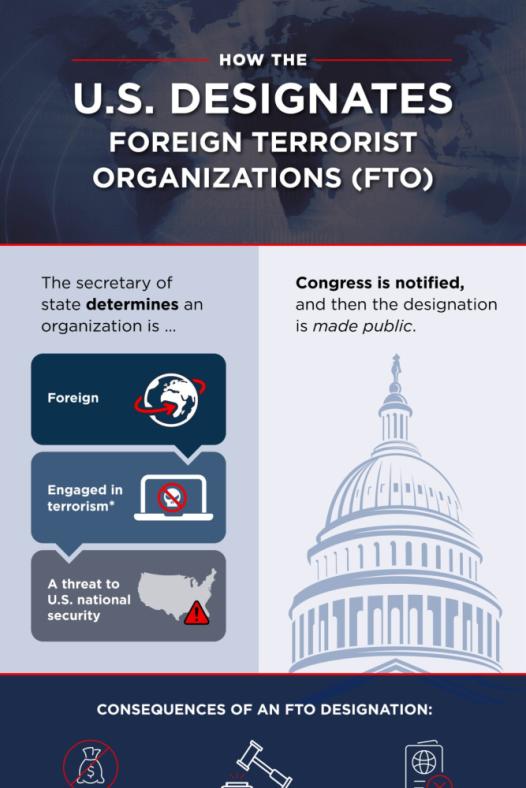When the United States designates a group as a terrorist organisation, it does more than make headlines—it triggers a powerful chain reaction that isolates, disrupts, and dismantles dangerous networks around the world.
These designations are not symbolic gestures. They are calculated legal tools that curb financial flows, restrict movement, and elevate international scrutiny. Whether applied to a well-known extremist group or a shadowy front organisation, the effect is clear: operating as a terrorist under US jurisdiction comes with consequences.
Behind the designation: how it works
The process starts quietly. Intelligence agencies, law enforcement, and diplomatic channels gather detailed evidence—publicly and behind the scenes—on a foreign group's activities. If the group meets the legal criteria of engaging in or supporting terrorism and poses a threat to US national security or foreign policy, the State Department begins the formal process.
This includes:
- A legal review of evidence,
- A coordinated interagency evaluation, and
- A notification to Congress, which has seven days to respond before the designation is published in the Federal Register.
There are two main designations used:
- Foreign Terrorist Organization (FTO): Under the Immigration and Nationality Act, this criminalizes providing any support—financial, material, or logistical—to the group.
- Specially Designated Global Terrorist (SDGT): Under Executive Order 13224, this freezes assets, blocks transactions, and allows sanctions on individuals or entities affiliated with the group.
These designations are reviewed regularly and can be challenged in court, ensuring that the process is not only rigorous but also transparent and accountable.
What happens after the label?
Once designated, a group's ability to operate shrinks dramatically. US banks freeze assets, financial institutions cut ties, and travel restrictions kick in. Those who try to raise money, spread propaganda, or provide any kind of support risk prosecution. Even individuals loosely connected to the group may face visa bans or be flagged for investigation.
Just as importantly, these designations ripple outward. Allies and partner nations often follow Washington's lead—cutting off funding routes, arresting operatives, and joining efforts to contain the threat.

The Resistance Front: Lashkar-e-Taiba's new mask
On July 18, 2025, the United States formally designated The Resistance Front (TRF)—a militant outfit operating in Indian-administered Kashmir—as both a Foreign Terrorist Organization (FTO) and a Specially Designated Global Terrorist (SDGT) entity.
TRF emerged in 2019, presenting itself as a local resistance movement. However, intelligence assessments and counterterrorism experts quickly exposed it as a proxy of Lashkar-e-Taiba (LeT), the Pakistan-based terror group responsible for the 2008 Mumbai attacks. The rebranding effort, analysts suggest, was designed to obscure LeT's involvement while maintaining operational reach across the border.
The designation came on the heels of a deadly April 2025 attack in Pahalgam, Kashmir. The shooting killed 26 civilians, including women and children—marking the deadliest terror attack in the region in more than a decade.
US Secretary of State Marco Rubio confirmed the link, stating, "TRF, a Lashkar-e-Tayyiba (LeT) front and proxy, claimed responsibility for the April 22, 2025, Pahalgam attack which killed 26 civilians."
India hailed the US move as both a diplomatic and strategic victory. India's External Affairs Minister S Jaishankar welcomed it as a "strong affirmation of India-US counterterrorism cooperation," while opposition leader Shashi Tharoor noted it could serve as a precedent for holding state sponsors of terror accountable.
Pakistan, however, took a defensive stance. Deputy Prime Minister Ishaq Dar asserted that Pakistan does not consider TRF an illegal entity and demanded concrete evidence of its involvement in the Pahalgam attack.
Yet, the global mood is shifting. The international community appears less tolerant of ambiguity and safe havens for groups with violent agendas.
A global strategy beyond labels
The TRF designation is about more than just justice for the victims of Pahalgam—it signals a broader American approach to counterterrorism. In a world where extremist groups rebrand and reemerge under new names, US designation tools serve as a flexible and forward-looking strategy.
By targeting financial networks, restricting travel, and sending a unified diplomatic signal, these measures quietly reinforce a powerful message: terrorism—regardless of its name or front—will face consequences.



Comments